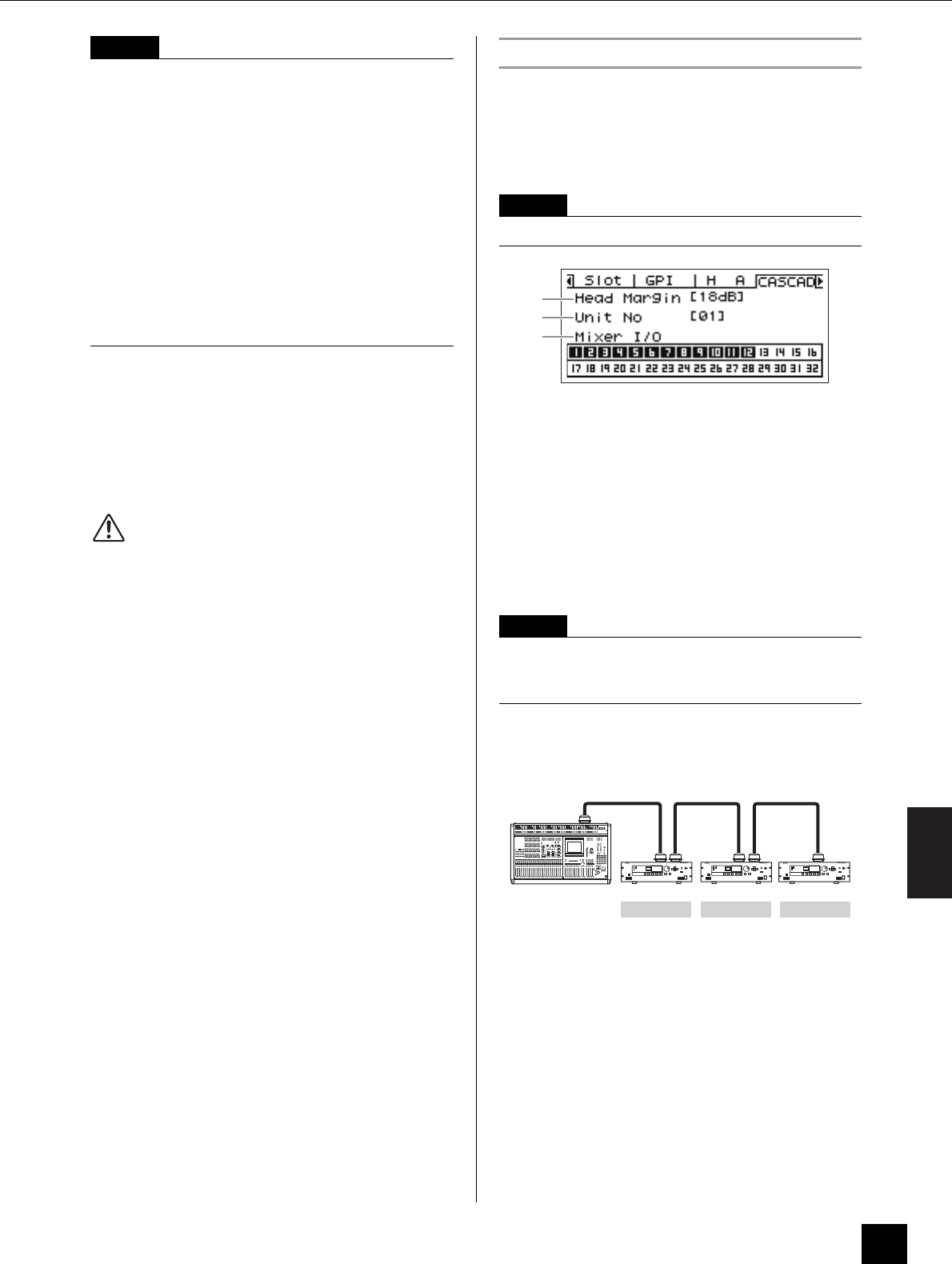
Panel Operation and Displays
Utility Displays
DME64N/DME24N Owner’s Manual
53
+48V
Individually turns phantom power ON or OFF for each
head amplifier channel.
Use the [ E ] and [ F ] buttons to position the cursor at
the desired channel, then press the [ENTER] button to
alternately turn phantom power for that channel ON and
OFF.
• Always turn the phantom power off when it is not
needed.
• When turning phantom power ON, make sure
that no equipment other than phantom-powered
devices such condenser microphones are
connected to the [IN] connectors (DME24N only).
Applying phantom power to a device that does
not require phantom power can damage the
device.
• Do not connect or disconnect a device to a [IN]
connector (DME24N only) while phantom power
is applied. Doing so can damage the connected
device and/or the unit itself.
• To prevent speaker and possible hearing
damage, be sure to turn power amplifiers OFF
when turning phantom power ON or OFF. It is
also a good idea to turn the output level all the
way down (page 39).
Phantom Master Switch (AD8HR only)
Displays overall phantom power ON or OFF.
High-pass Filter (HPF) (AD8HR only)
Individually turns the high-pass filter for each AD8HR
head amplifier channel ON or OFF. This parameter is
only available for the AD8HR head amplifier. Use the [ E
] and [ F ] buttons to select a channel, then press the
[ENTER] button to turn the HPF for that channel ON or
OFF.
High-pass Filter Frequency (Frq)
(AD8HR only)
Individually sets the high-pass filter frequency for each
AD8HR head amplifier channel. This parameter is only
available for the AD8HR head amplifier.
Edit using the “Numeric Parameters” editing procedure
described on page 36.
Cascade Setup (CASCAD) Page
Shows the status of the [CASCADE] connectors. Refer to
“CASCADE Connection” on page 31 for connection
details.
Settings are made from the DME Designer application
running on the connected computer.
Head Margin
Displays the head margin for cascade connection.
18dB: Use this setting when cascading DME64N
units or when connecting to a mixer’s normal
cascade bus.
0dB: Use this setting when connecting to a PM5D
in situations in which the PM5D SLOT OUT port
signal is being output via the CASCADE OUT
terminal.
Unit No
Shows how many devices the unit is from the beginning
of the cascade chain.
Mixer I/O
Displays whether the cascade signal is bus shared or
not.
: A DME64N connected directly to the mixer is
connected to a second DME64N on this
unidirectional channel.
Input on the same channel from other DME64N
units will be independent.
: This channel is being used for bidirectional bus
shared connection between DME64N units. Input
on the same
channel from other DME64N units will be summed.
NOTE
The gain of the DME24N internal head amplifiers can be
adjusted from +10 dB to –60 dB in 1-dB increments. The
internal circuitry switches at about the –45-dB point, and
the signal is automatically muted at that point to prevent
noise.
The AD8HR gain can be adjusted from +10 dB to –62 dB
in 1-dB steps, and the AD824 gain can be adjusted from
+10 dB to –62 dB in 6-dB steps.
The PAD will be internally switched on or off when the
gain of the DME24N built-in head amplifier is adjusted
between -8 dB and -7 dB. Keep in mind that noise may
be generated if there is a difference between the Hot
and Cold output impedance of the external device
connected to the IN connector when using phantom
power.
CAUTION
NOTE
This page only appears on the DME64N.
NOTE
The Head Margin setting only applies when connected
to a mixer. When the DME64N is connected to another
DME64N unit, head margin is fixed at 18 dB.
PM5D
DME64N DME64N
IN OUT
OUT
DME64N
IN
IN OUT
Unit No = 01 Unit No = 02 Unit No = 03


















